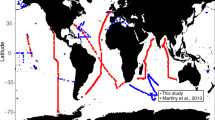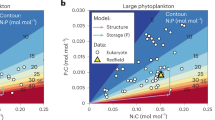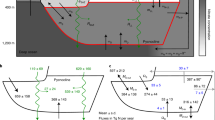Abstract
The major nutrients nitrate and phosphate have one of the strongest correlations in the sea, with a slope similar to the average nitrogen (N) to phosphorus (P) content of plankton biomass (N/P = 16:1). The processes through which this global relationship emerges despite the wide range of N/P ratios at the organism level are not known. Here we use an ocean circulation model and observed nutrient distributions to show that the N/P ratio of biological nutrient removal varies across latitude in Southern Ocean surface waters, from 12:1 in the polar ocean to 20:1 in the sub-Antarctic zone. These variations are governed by regional differences in the species composition of the plankton community. The covariation of dissolved nitrate and phosphate is maintained by ocean circulation, which mixes the shallow subsurface nutrients between distinct biogeographic provinces. Climate-driven shifts in these marine biomes may alter the mean N/P ratio and the associated carbon export by Southern Ocean ecosystems.
This is a preview of subscription content, access via your institution
Access options
Subscribe to this journal
Receive 51 print issues and online access
$199.00 per year
only $3.90 per issue
Buy this article
- Purchase on Springer Link
- Instant access to full article PDF
Prices may be subject to local taxes which are calculated during checkout




Similar content being viewed by others
References
Redfield, A. C. The biological control of chemical factors in the environment. Am. Sci. 46, 205–221 (1958)
Sterner, R. W. & Elser, J. J. Ecological Stoichiometry: The Biology of Elements from Molecules to the Biosphere 80–134 (Princeton Univ. Press, 2002)
Falkowski, P. G. Rationalizing elemental ratios in unicellular algae. J. Phycol. 36, 3–6 (2000)
Anderson, L. A. & Sarmiento, J. L. Redfield ratios of remineralization determined by nutrient data analysis. Glob. Biogeochem. Cycles 8, 65–80 (1994)
Takahashi, T., Broecker, W. S. & Langer, S. Redfield ratio based on chemical data from isopycnal surfaces. J. Geophys. Res. 90, 6907–6924 (1985)
Codispoti, L. A. in Productivity of the Ocean: Past and Present (eds Berger, W. H., Smetacek, V. S. & Wefer, G.) 377–394 (Wiley, 1989)
Broecker, W. S. Glacial to interglacial changes in ocean chemistry. Prog. Oceanogr. 2, 151–197 (1982)
Tyrrell, T. The relative influences of nitrogen and phosphorus on oceanic primary production. Nature 400, 525–531 (1999)
Geider, R. J. & La Roche, J. Redfield revisited: variability of C:N:P in marine microalgae and its biochemical basis. Eur. J. Phycol. 37, 1–17 (2002)
Quigg, A. et al. The evolutionary inheritance of elemental stoichiometry in marine phytoplankton. Nature 425, 291–294 (2003)
Finkel, Z. V. et al. Irradiance and the elemental stoichiometry of marine phytoplankton. Limnol. Oceanogr. 51, 2690–2701 (2006)
Klausmeier, C. A., Litchman, E., Daufresne, T. & Levin, S. A. Optimal nitrogen-to-phosphorus stoichiometry of phytoplankton. Nature 429, 171–174 (2004)
Gruber, N. & Sarmiento, J. L. Global patterns of marine nitrogen fixation and denitrification. Glob. Biogeochem. Cycles 11, 235–266 (1997)
Karl, D. M. & Michaels, A. F. in Encyclopedia of Ocean Sciences Vol. 4 (eds Steele, J. H., Turekian, K. K. & Thorpe, S. A.) 1876–1884 (Academic, 2001)
Dentener, F. et al. Nitrogen and sulfur deposition on regional and global scales: a multimodel evaluation. Glob. Biogeochem. Cycles 20, GB4003 (2006)
Codispoti, L. A. & Christensen, J. P. Nitrification, denitrification, and nitrous oxide cycling in the eastern tropical Pacific Ocean. Mar. Chem. 16, 277–300 (1985)
Garcia, H. E., Locarni, R. A., Boyer, T. P. & Antonov, J. I. World Ocean Atlas 2005 Vol. 4 Nutrients (Phosphate, Nitrate, Silicate) (US Government Printing Office, 2006)
Orsi, A. H., Whitworth, T. W. & Nowlin, W. D. On the meridional extent and fronts of the Antarctic Circumpolar Current. Deep-Sea Res. I 42, 641–673 (1995)
Schlitzer, R. Carbon export fluxes in the Southern Ocean: results from inverse modeling and comparison with satellite-based estimates. Deep-Sea Res. II 49, 1623–1644 (2002)
Green, S. E. & Sambrotto, R. N. Plankton community structure and export of C, N, P and Si in the Antarctic Circumpolar Current. Deep-Sea Res. II 53, 620–643 (2006)
Longhurst, A. Seasonal cycles of pelagic production and consumption. Prog. Oceanogr. 36, 77–167 (1995)
Kopczynska, E. E., Weber, L. H. & El-Sayed, S. Z. Phytoplankton species composition and abundance in the Indian sector of the Antarctic Ocean. Polar Biol. 6, 161–169 (1986)
Jin, X., Gruber, N., Dunne, J. P., Sarmiento, J. L. & Armstrong, R. A. Diagnosing the contribution of phytoplankton functional groups to the production and export of particulate organic carbon, CaCO3, and opal from global nutrient and alkalinity distributions. Glob. Biogeochem. Cycles 20, GB2015 (2006)
Price, N. M. The elemental stoichiometry and composition of an iron-limited diatom. Limnol. Oceanogr. 50, 1159–1171 (2005)
Fu, F. X., Warner, M. E., Zhang, Y. H., Feng, Y. Y. & Hutchins, D. A. Effects of increased temperature and CO2 on photosynthesis, growth, and elemental ratios in marine Synechococcus and Prochlorococcus (Cyanobacteria). J. Phycol. 43, 485–496 (2007)
Arrigo, K. R. et al. Phytoplankton community structure and the drawdown of nutrients and CO2 in the Southern Ocean. Science 283, 365–367 (1999)
Karl, D. et al. The role of nitrogen fixation in biogeochemical cycling in the subtropical North Pacific Ocean. Nature 388, 533–538 (1997)
Wu, J. F., Sunda, W., Boyle, E. A. & Karl, D. M. Phosphate depletion in the western North Atlantic Ocean. Science 289, 759–762 (2000)
Anderson, R. F. et al. Wind-driven upwelling in the Southern Ocean and the deglacial rise in atmospheric CO2 . Science 323, 1443–1448 (2009)
Elderfield, H. & Rickaby, R. E. M. Oceanic Cd/P ratio and nutrient utilization in the glacial Southern Ocean. Nature 405, 305–310 (2000)
Sarmiento, J. L. & Toggweiler, J. R. A new model for the role of the oceans in determining atmospheric PCO2 . Nature 308, 621–624 (1984)
Le Quere, C. et al. Saturation of the Southern Ocean CO2 sink due to recent climate change. Science 316, 1735–1738 (2007)
Sarmiento, J. L. et al. Response of ocean ecosystems to climate warming. Glob. Biogeochem. Cycles 18, GB3003 (2004)
Khatiwala, S., Visbeck, M. & Cane, M. A. Accelerated simulation of passive tracers in ocean circulation models. Ocean Model. 9, 51–69 (2005)
Brzezinski, M. A. et al. A switch from Si(OH)4 to NO3 − depletion in the glacial Southern Ocean. Geophys. Res. Lett. 29, 1564 (2002)
Acknowledgements
We thank S. Khatiwala for providing the transport matrix. This work was funded by grants from the National Science Foundation and the Gordon and Betty Moore Foundation. Additional support for T.S.W. was provided by a Pauley Fellowship from UCLA.
Author information
Authors and Affiliations
Contributions
T.S.W. conducted the simulations and analysed the results. C.D. designed the study. Both authors wrote the paper.
Corresponding author
Ethics declarations
Competing interests
The authors declare no competing financial interests.
Supplementary information
Supplementary Information
This file contains Supplementary Methods, Supplementary Tables 1-3, Supplementary Notes on sensitivity testing, Supplementary Figures 1-6 with legends and additional references. (PDF 4248 kb)
Rights and permissions
About this article
Cite this article
Weber, T., Deutsch, C. Ocean nutrient ratios governed by plankton biogeography. Nature 467, 550–554 (2010). https://doi.org/10.1038/nature09403
Received:
Accepted:
Published:
Issue Date:
DOI: https://doi.org/10.1038/nature09403
This article is cited by
-
Consistent stoichiometric long-term relationships between nutrients and chlorophyll-a across shallow lakes
Nature Communications (2024)
-
Changes in nutrient stoichiometry in responding to diatom growth in cyclonic eddies
Geoscience Letters (2023)
-
Calcium isotope ratios of malformed foraminifera reveal biocalcification stress preceded Oceanic Anoxic Event 2
Communications Earth & Environment (2022)
-
Global patterns in marine organic matter stoichiometry driven by phytoplankton ecophysiology
Nature Geoscience (2022)
-
Enhanced silica export in a future ocean triggers global diatom decline
Nature (2022)
Comments
By submitting a comment you agree to abide by our Terms and Community Guidelines. If you find something abusive or that does not comply with our terms or guidelines please flag it as inappropriate.



